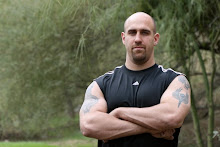I often receive emails about designing sport-specific programs especially with sandbags. Many coaches are embracing the idea as sandbags are as close as one can train dealing with a live opponent. That makes sports such as American football, basketball, wrestling, mma, martial arts, hockey, and many others perfect for utilizing sandbags. However, we need to examine what we truly mean by sport-specific training.
To perform true sport-specific work we need to look at the demands of the sport, but the individual as well. Some texts suggest an athlete should not participate in sport-specific programs until a five year base has been used. This may surprise many that make youngsters participate in "sport-specific" programs. Base qualities need to be developed as this will make more sense as we delve into more particulars.
The challenge of sport-specific training is that it has to be very carefully chosen and the amount has to be well applied depending upon the time of year. SPP (specialized physical preparation) and GPP (generalized physical preparation) are often thought to be mutually exclusive. The truth of the matter is they both co-exist throughout the training year. The difference can exist in how much of one or another are used. In the early off-season, more GPP methods should be emphasized to counterbalance the overuse injuries and movements that the particular sport creates. As the off-season progresses into other parts of the year then more specialized techniques should be the primary objective.
Here is the kicker though, rarely do coaches and trainers have athletes throughout such prolonged periods of time in perfect situations. Having worked with professional athletes and spoken with many coaches that work with this group as well, I can tell you the text book version is not reality. One has to be critical enough to determine the best methods to help the athlete get back into optimal training shape. This may mean improving one's body composition and strength-endurance, it may mean improving their dynamic flexibility in specific patterns, it may require raising maximal strength and adding functional muscle mass. Heck, at times it may seem like all of these are needed!!
Sport-specific programs can do their best by realizing that they are not always so specific. The original concept is far more complicated than most give it credit. Analyzing exact movement angles to determine when certain forces are applied is beyond the scope of many training regime's. The truth of the matter, it may not be all that essential anyways when we look at the life of a modern athlete that includes not living at sports training dorms year round.
Don't worry, all is not lost! There are some ideas that I have put together that can help athletes apply some of our concepts and get the most out of their training.
1. Learning explosive drills such as shouldering, snatching, and push jerks are terrific in learning hip power for running, jumping, skating, etc.
2. Overhead work should be an emphasis (contrary to what some coaches say) as often weaknesses throughout the body can be found when one is not able to stabilize weight overhead. In addition, putting one's hands overhead is a pretty fundamental movement pattern.
3. Utilize shoulder lunging, step-ups, and other drills to counterbalance leg differences and instabilities.
4. Rotational drills such as the Around the World, shoveling, and others are more beneficial than drills such as Russian twists as it teaches integration of the hip and torso to produce and resist rotation.
5. Zercher squats and their variations are strong ways in improving dynamic flexibility and core strength.
6. Get-ups may be one of the best dynamic hip drills around!
7. The Jungle Gym hip raise might be the single best way to remove overactive hip flexors and allow and athlete to utilize their hamstrings.
8. Isometric upper body strength from drills like hand walking are amazing for shoulder stabilization, trunk training, and pushing strength. Use bands or the Jungle Gym to make it more challenging.
9. Sandbag complexes may be the single most demanding means in losing fat and gaining functional muscle mass.
10. Be creative and go through any movement pattern possible. People forget the great part of sandbags is their versatility. You can do anything with a barbell, dumbbell, or kettlebell with a sandbag, except it is just more challenging.
See how much better of an athlete you can create or be by applying these easy to follow guidelines!
Tuesday, August 5, 2008
Subscribe to:
Post Comments (Atom)





No comments:
Post a Comment